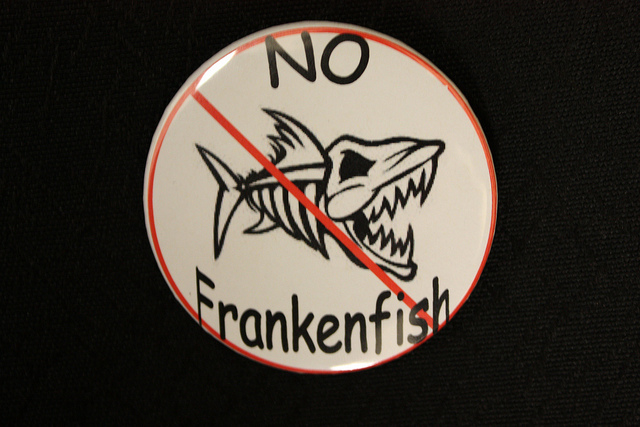
03 Mar EARTH MATTERS: SOMETHING’S FISHY
The fight over genetically modified salmon
 In this column, I plan to talk about genetically modified salmon: Am I eating it? What is it? Why is it a problem?
In this column, I plan to talk about genetically modified salmon: Am I eating it? What is it? Why is it a problem?
First – You are not eating it… yet.
However, the United States Food and Drug Administration (FDA) is currently in the process of determining whether you might be eating it soon, and, if you are, whether you will know. In September 2010, over a decade after it first began to consider AquaBounty Technology’s application for genetically modified salmon, the FDA held public hearings on approval of AquAdvantage® salmon and on whether labeling should be required if the fish is approved. As of now, the FDA has still not made a decision.
These two hearings encapsulated most of the arguments over genetically modified organisms (GMOs) that have been debated in the nearly 30 years that GM products have been available for commercial sale. Are GMOs safe for the environment and human consumption? Do they provide environmental risks or benefits? Who reaps the economic benefit? Are they “substantially equivalent” to non-GM products, and, even if so, should consumers have the right to choose what they are eating?
Experimentation with genetically modified fish began in the mid-1980s. The first genetically modified fish was patented in the US in 1996, and in 2000 A/F Protein (now AquaBounty) first applied to the FDA for commercial approval of growth-enhanced genetically modified salmon. This genetically modified Atlantic salmon – named AquAdvantage® by its developers –is engineered with a growth hormone and an antifreeze gene and is designed for faster growth. The developers have touted the benefits of a decreased residence time and increased feed efficiency.
Opponents, on the other hand, note that it may pose serious ecological risks, including many that are similar to those posed by current commercial salmon aquaculture, including disease and sea lice infestations, pollution from concentrated fish farms, competition from escaped fish, unsustainable rates of fish feed use, and high mercury and PCB levels in farmed fish. On top of these problems, through a combination of short-term beneficial fitness effects – like increased mating success due to larger size – coupled with long-term negative fitness effects – like decreased swimming ability (and increased predation) due to immaturity – populations could even go extinct, in what is known as the “Trojan gene” effect.
Regulating Genetically Modified Fish
The initial decision by the FDA to regulate genetically modified fish engendered considerable consternation among people concerned about the salmon. The principal ones, brought up at the FDA hearings by several speakers – including me, representing Ocean Conservancy – involved the lack of transparency and the reliance on the applicant’s own data for review, as well as questions about the FDA’s ability adequately to review ecological risks. The FDA, because its process is set up to review drug applications, defers considerably to the applicant in keeping information about the application secret, in order to protect trade secrets and proprietary information. It also does not have expertise in producing environmental assessments, especially for animals that may escape into the wild.
The biotechnology industry vs. anti-GM activists: a proxy battle
The debate over AquaBounty’s salmon both recalls old and foreshadows new arguments about biotechnology. The proponents of the fish promise benefits to human health and to the environment, and claim that their fish will fill a need to feed a growing demand for seafood protein. At the same time, they complain that those who challenge these claims and the closed FDA process are ignorant or “hysterical.”
Opponents of the fish also raise broader arguments about biotechnology in their comments on the application and in calls to activists in their networks, highlighting issues of corporate control and lack of consumer choice. The fight over “Frankenfish” has also played into growing U.S. efforts to label GMOs.
Conclusion
Both opponents and proponents suspect that an FDA approval of genetically modified salmon would lead swiftly to further approvals of animal biotechnology products, both for human consumption and for medical or other uses. These include the “Enviropig,” a pig designed to produce cleaner feces; goats that produce spider silk in their milk; prion-free cows; and pigs that produce organs for xenotransplantation to humans.
What happens with AquaBounty’s genetically modified salmon will have repercussions for other genetically modified animals, but it is already having an effect on GM politics in the United States. The US federal regulatory system is set up largely as an ex post system, where problems are dealt with after the fact and few precautionary elements are included. With a lack of post-release monitoring by regulatory agencies, the premise of controlling problems only after they are discovered is flawed. When the potential consequences of release are particularly troubling, as with escaped genetically modified fish into sensitive ecosystems or accidental release of pharm crops into the food system, a precautionary approach requires understanding the likelihood of containment, and the impacts of even low level gene escape.
Activists have therefore not only been pressuring the FDA not to approve the AquAdvantage® salmon without considerable further study, but have also supported bills introduced in the US Congress, subnational bans and labeling efforts, and legal action. Thus far, the genetically modified salmon is still swimming in circles. And in the meantime, the fight over the fish has generated media and public attention to the broader question of what role GMOs should play in the future of food.
For more information, see Ocean Conservancy’s nifty infographic about genetically modified salmon, with more information at this site, as well as the Just Label It campaign at http://justlabelit.org/ to support labeling for all genetically modified products.
Note: Images show a comparison between genetically modified and regular Coho salmon at one year. Photo credit: Bob Devlin
Frankenfish pin handed out by Senator Mark Begich (D-AK) for Halloween. Photo credit: Mark Begich



Rosy
Posted at 14:19h, 03 MarchThanks Anna, very informative…
Amy Pearson
Posted at 11:01h, 06 MarchOrganic foods remain an area of growth even with the rising cost of grocery items and tougher economic times. Turns out organic cooking is really not that complicated once you know a few basics. In fact, it’s way easier and healthier.
Pingback:EARTH MATTERS: THE FRANKENFISH COMETH? | Telluride Inside… and Out
Posted at 22:19h, 26 April[…] about GE salmon in the past – this link on Telluride Inside… and Out is an example – see this link – describing some of the problems with the FDA being the lead agency reviewing the […]